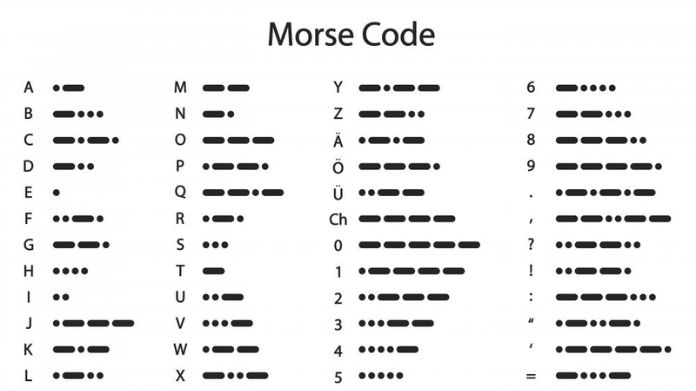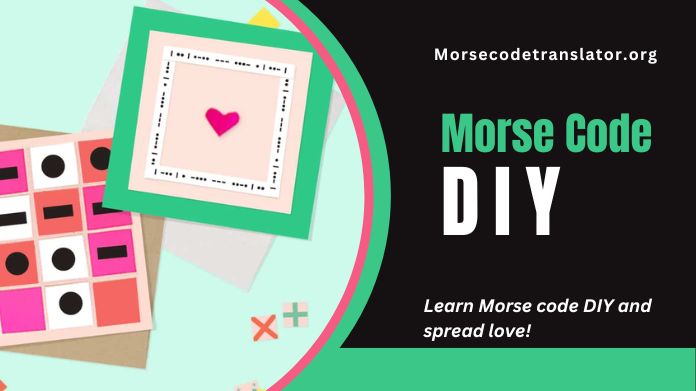As Valentine’s Day approaches, many seek creative ways to express their love and appreciation for their special someone. Morse Code DIY cards offer a unique and heartfelt way to convey messages of affection, adding an element of intrigue and personalization to the traditional gesture of giving cards.
By translating sentiments into the dots and dashes of Morse Code, these DIY cards create a secret language between sender and recipient, enhancing the intimacy of the exchange. In this guide, we explore the art of Morse Code DIY cards, providing inspiration and step-by-step instructions for crafting memorable Valentine’s Day greetings.
From choosing meaningful messages to mastering the Morse Code alphabet, each card becomes a canvas for personal expression and connection. Whether you’re a crafting enthusiast or embarking on your first DIY project, these Morse Code cards offer a delightful opportunity to infuse your Valentine’s Day celebrations with creativity and sentiment.
Join us as we delve into Morse Code DIY, where every dot and dash carries a message of love, making Valentine’s Day an occasion to cherish and remember.
Understanding Morse Code: A Language of Dots and Dashes

Morse Code, with its rhythmic sequence of dots and dashes, holds a timeless allure as one of the oldest forms of communication in the digital age. Developed in the early 19th century by Samuel Morse and Alfred Vail, this ingenious encoding system revolutionized long-distance communication, allowing messages to traverse vast distances via telegraph wires.
In today’s world, Morse Code continues to captivate enthusiasts, symbolizing a bygone era of innovation and connectivity. Despite advances in technology, its simplicity and elegance endure, making it a fascinating subject of study and exploration.
Widely used in telegraphy, maritime communication, and military operations, it played a crucial role in connecting distant parts of the world. Despite being largely replaced by digital technologies, Morse Code remains popular among amateur radio operators and enthusiasts.
Its rhythmic patterns and efficiency make it an enduring symbol of human ingenuity and the power of communication. With its rich historical significance and cultural impact, Morse Code continues to fascinate and inspire people worldwide.
Why Morse Code DIY for Valentine’s Day?
Morse Code DIY for Valentine’s Day offers a charming and intimate way to express love and affection. By translating heartfelt messages into the language of dots and dashes, these DIY cards add a delightful element of mystery and personalization to traditional Valentine’s Day greetings.
The appeal of Morse Code DIY lies in its uniqueness and creativity. Rather than relying on conventional expressions of love, such as pre-written cards or store-bought gifts, Morse Code DIY allows individuals to craft personalized messages that hold special meaning for both sender and recipient.
Moreover, Morse Code DIY cards offer a fun and interactive experience for both parties. Deciphering the hidden messages adds an element of surprise and excitement to the recipient’s Valentine’s Day celebration, making it a memorable and cherished experience.
Furthermore, Morse Code DIY is accessible to everyone, regardless of crafting skill level. With just a few basic materials and a little creativity, anyone can create beautiful and meaningful DIY cards that convey their love and appreciation in a unique and heartfelt way.
Materials You’ll Need for Morse Code DIY
1. Cardstock or Blank Cards: Choose sturdy paper or pre-folded blank cards as the base for your Morse Code Valentine’s Day cards.
2. Markers or Pens: Select markers or pens in various colors to add a creative flair to your designs.
3. Ruler: A ruler will help you create clean and precise lines on your cards.
4. Morse Code Guide: Print or have a Morse Code guide handy to translate your message into dots and dashes accurately.
Steps to Craft Your Morse Code DIY Valentine’s Day Cards

Step 1: Design Your Card
Begin by selecting the overall design of your card. Consider the color scheme, layout, and any additional elements you want to include. Traditional Valentine’s Day symbols like hearts and Cupid can complement your Morse Code message.
Step 2: Choose Your Message
Select a meaningful message or phrase that you want to convey. It could be a simple “I love you,” a favorite quote, or a personal sentiment that holds significance for you and the recipient.
Step 3: Translate Your Message to Morse Code
Refer to your Morse Code guide and translate each letter of your chosen message into dots and dashes. Leave spaces between each Morse Code representation of the letters.
For example:
- “I” is represented by “..”
- “Love” translates to “.-.. — …- .”
Step 4: Create Morse Code Patterns on the Card
Create the Morse Code patterns on the card using your markers or pens. Use a ruler to maintain straight lines and consistent spacing. You can experiment with different colors for dots and dashes to enhance the visual appeal of your design.
Step 5: Add Decorative Elements
Embellish your card with additional decorations that complement the Morse Code patterns. Consider incorporating hearts, flowers, or other symbols associated with love and Valentine’s Day.
Step 6: Write the Translation Inside
To ensure your recipient can decipher the Morse Code, write the translation of your message inside the card. This adds an interactive element, allowing them to engage with the card and discover the hidden sentiment.
Step 7: Personalize the Envelope
Extend the Morse Code theme to the envelope by adding a few dots and dashes, subtly teasing the recipient about the hidden message. This extra touch adds an element of excitement before the card is even opened.
Tips for Morse Code DIY Valentine’s Day Cards
Expressing love and affection on Valentine’s Day sometimes requires more than conventional methods. If you want to add a unique and personal touch to your Valentine’s Day celebration, Morse Code DIY Valentine’s Day cards offer a creative and thoughtful way to convey your feelings.
Morse Code, the dots and dashes representing letters and numbers, provides a secret and playful language for your messages. Here are some tips to create heartfelt Morse Code DIY Valentine’s Day cards that will leave a lasting impression on your special someone.
1. Select Your Message:
Before diving into the creative process, decide on the message you want to convey. Whether it’s a classic “I love you” or a personalized inside joke, choose a message that holds sentimental value for you and your Valentine.
2. Learn Morse Code Basics:
Familiarize yourself with Morse Code symbols. A combination of dots (.) and dashes (-) represents each letter and number. Numerous online resources and charts can help you decode and encode messages in Morse Code.
3. Gather Materials:
Collect the required materials for your DIY project. You’ll need blank cards or cardstock, writing utensils, and decorations. Consider using colored pens, markers, or watercolors to add a vibrant touch to your cards.
4. Plan Your Design:
Before you start, sketch a rough design for your Morse Code Valentine’s Day card. Decide where to place the Morse Code message and any additional embellishments. Planning will help ensure a visually appealing and well-balanced card.
5. Create Morse Code Messages:
Once you’ve planned your design, translate your chosen message into Morse Code. Write out the dots and dashes corresponding to each letter, leaving spaces between words. This is where your knowledge of Morse Code basics comes into play.
6. Incorporate Visual Elements:
Enhance your cards by incorporating visual elements that complement the Morse Code message. Consider including hearts, flowers, or other symbols that resonate with the theme of love and Valentine’s Day. Be mindful of the overall aesthetics to create an eye-catching and cohesive design.
7. Experiment with Fonts:
Play around with different fonts and lettering styles for the Morse Code message. Experimenting with various fonts can add a touch of personality to your cards. Pick a style that aligns with the overall design and theme of your Valentine’s Day cards.
8. Add a Key or Legend:
Include a key or legend on the card to ensure your Valentine can decipher the Morse Code. This can be a small section that explains how to read the dots and dashes, making the decoding process a fun and interactive experience for your recipient.
9. Include a Traditional Message:
While the Morse Code message adds a unique element to your DIY Valentine’s Day card, include a traditional message inside the card. Express your feelings in words to ensure that your heartfelt sentiments are fully understood.
10. Personalize Each Card:
If you’re creating multiple Morse Code Valentine’s Day cards, personalize each to make them unique. Consider adding individualized touches, such as inside jokes, memories, or personalized symbols that hold significance for each recipient.
Conclusion
Morse Code DIY cards add a playful twist to expressing love in a sea of typical Valentine’s Day gestures. Crafting these cards isn’t just a creative project; it’s a thoughtful way to make your messages stand out.
The secret Morse Code language adds an element of surprise, turning decoding into a fun experience. In the realm of love, where small gestures mean the most, these cards offer a chance to be both creative and heartfelt.
So, embrace the opportunity to make your Valentine’s Day extraordinary with a sweet and simple “I love you” in a language only you both understand.
